Well here we are all then, in an unprecedented situation for humanity. And like Steve said I’m not going to enter this hotbed of controversy here other than hoping that all who read this are safe and well, take good care of yourselves and each other. So, we all have had restrictions put on us that have restricted our movements and as you have probably gathered from some of my previous articles; I am a man who likes to get out and about.
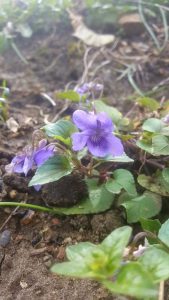
With this situation in place and living in crowded Surrey I have found myself in my reserve a lot of the time in the last 3 weeks. In all honesty, I have needed a lot of time out there in order to regain some kind of control, as helped by the incredibly mild winter, certain familiar species had run rampant through many of the planted-up areas. To the gardeners amongst you will know about the ‘ familiar ‘ species I am referring to and over the winter I had noticed how many plant species had not died off or wilted due to the mild conditions and when I finally got there to deal with it I instantly realised that this was going to be a big task and regretted for not starting to deal with issue a bit earlier. After 3 weeks of doing a minimum of half an hour daily weeding I have just about ‘ cleaned ‘ the flower beds and there are two very large piles of Creeping Buttercups, Broad Leaved Dock and Pendulous Sedge that I have dug, pulled and scraped out of the ground in order to try and redress the balance. I have already previously mentioned that I was aware that this kind of situation could occur in my new reserve and, given the habitats surrounding the area and the tenacity of the problem species I have been dealing with, is never to be underestimated.

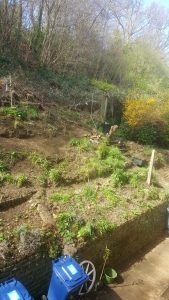
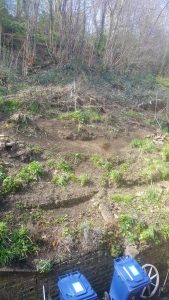
After I had removed as much as I could I started to think of ways to try and slow down this invasion and stop it happening every year. I realised my best chance to abate the weeds was to plant another strong growing species to try establish themselves before the problem species take over again
I had a little look into the woods just behind the reserve area to see which plants were growing on the woodland floor with the thought of finding a suitable species to plant on the edge of my area to try and stop the deluge of Ranuculus. Before you start thinking that I was stealing plants and going against all the things we are taught about picking wildflowers, I will say that the 20 plants I did end up digging out were A) very common. B) in an area where they were often trodden on by the many members of the public who use the woods and C) planting them 50 metres from where I dug them up was actually helping to extend their range in the area. The plants were Ramsons, wild garlic, and there are several large patches in the woods and when they are in flower they give that pleasant garlic odour and beautiful white flowers that will attract a few insects. Ramsons can form quite dense carpets on woodland floors which is I’m hoping is what my transplants will be doing on the edge on my reserve. As I’m becoming more aware of the power of the invasive weeds I felt that the Ramsons would need some time to get established and as we enter the start of the growing season, I knew all the invasive species would start growing all over again, particularly in the newly weeded areas where I had planted the Ramsons. I had a good think about other plant species that could compete with the problem species and one potential species was found accidentally whilst I looked through my collection of seeds (which was itself quite strange as the they were only wildflower seeds I had) Red Campion which seemed a good species to join in the battle. Their reddish pink flowers are in flower from April to July and are also quite shade tolerant which is good as where I was planting was going to be partially shaded. A common species in hedgerows and woodland and, like Ramsons, can form quite dense areas. I sowed some of the seeds directly into the ground in between the Ramson transplants and I also sowed some into pot that I took indoor to try and give them a bit of a head start.
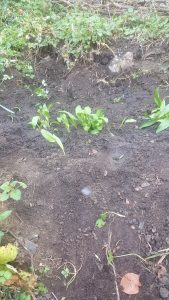
After 2 weeks there are already signs of life in the potted seeds.
I also added one more species to help stop the invasion, Wild Strawberry, which again is a species that can grow rapidly and form dense covering. I was given a single plant last year which I planted in midsummer and by the end of the summer had already flowered and fruited and spread. I have only planted a couple of plants and will see how they get on in the battle. Some of you may be well aware that the species that I have planted in order to try and dissuade invasive species can themselves be quite invasive and I have cleared them in several gardens I have worked in the past. I was well aware of this myself before I planted them and knew that I could be pulling them out in a few years if they got established over the course of this year. In their defence they all produce flowers that are vital nectar sources for potential visiting insects and will offer a visually beautiful show of colours hopefully.
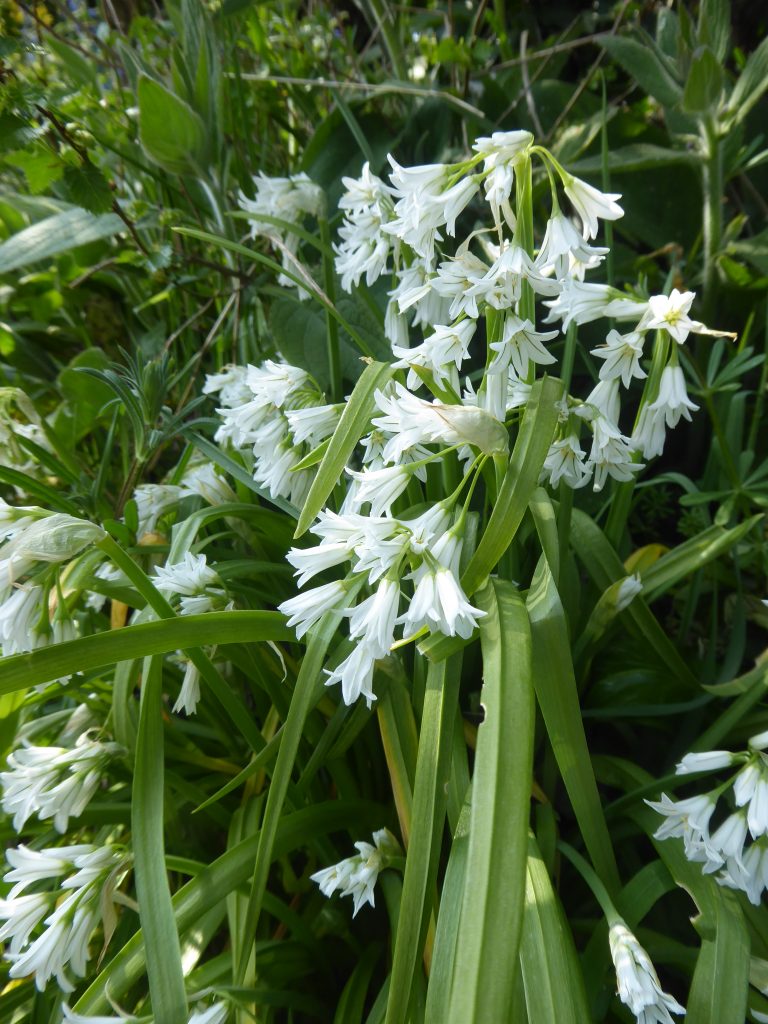

We can only wait and see what happens in the forthcoming weeks as spring progresses. And as I’ve quite a bit more to do!
As I have spent a lot of time out in the area I had cleared and planted up over the last couple of years I started to look at the gardens next to my plot which were all totally overgrown and in a state of poor condition. With a lot more time on my hands I took the decision to try and clear and dig over the ground to prepare the ground ready to replant and further extend the area of the ‘reserve ‘. On one side I began to dig over the earth removing the sods of earth as I went along. This area had once been garden but had not been touched for at least 6 years and most of the area was covered with grass and various other weeds. So far I have managed to dig over about a third of the area and still have a fair amount of digging and weeding to do before I plant up the new space. On the other side of the garden, the other overgrown area was a bit more of a challenge as there were a few major issues. Bramble invasion I could deal with and happily hacked back the sections where they had invaded. I then began to cut the rank grass down and soon discovered that the grass had grown through matting that had been laid years ago in order to prevent weeds growing! This was going to be a massive job and one that I have yet to start, ah well, I’ve got some time.
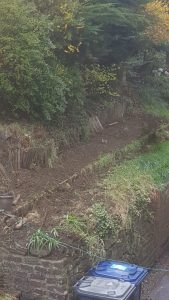
With all this activity was there actually any wildlife using the area?
It is massively reassuring when I see the local life in the area I have created and with a bit more time on my hands I have felt very rewarded to observe some things that have been seen. I began to put out some monkey nuts in the evening and the locals Badgers soon made an appearance and have seen them a few nights. I can hear, when my window is open, the cracking of the nutshells and know that they are about or so I thought for the other night I heard the shell cracking and took a look out the window and saw a big dog Fox waltzing around and occasionally cracking a nutshell. Due to a change in lighting at the flats where I live the reserve area is now much darker than it used to be and observations are a little bit harder to make.
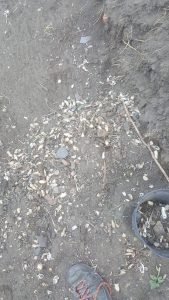
During the day time there has been a lot of Bumblebee activity with at least 3 different species observed, Buff Tailed, White Tailed and Early. I’ve seen a White-Tailed Queen investigating the walls at the bottom of garden looking for potential nest sites. Often in the mornings I’m seeing many bird species feeding around the area where the night shift has fed including Wood Pigeon, Magpie, Blackbird, Robin, Dunnock and for the last week a Song Thrush has been regularly seen. Bullfinches have been fairly regular and the male’s mournful song has been heard on a few days. Summer migrants have started to arrive and there was a Blackcap up in the woods along with a Chiffchaff.
As nature bursts into life , we shall see what this strange years brings.
